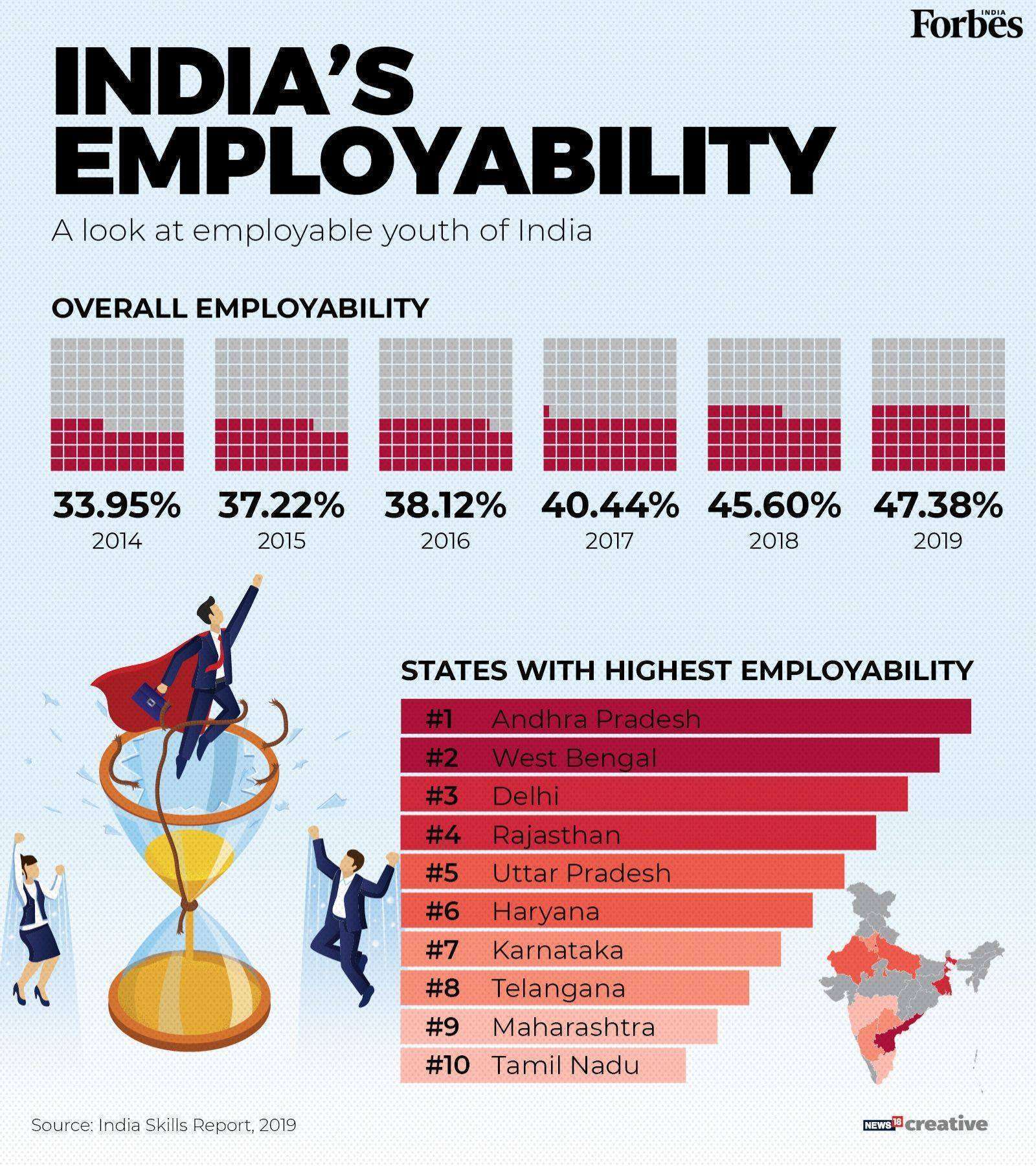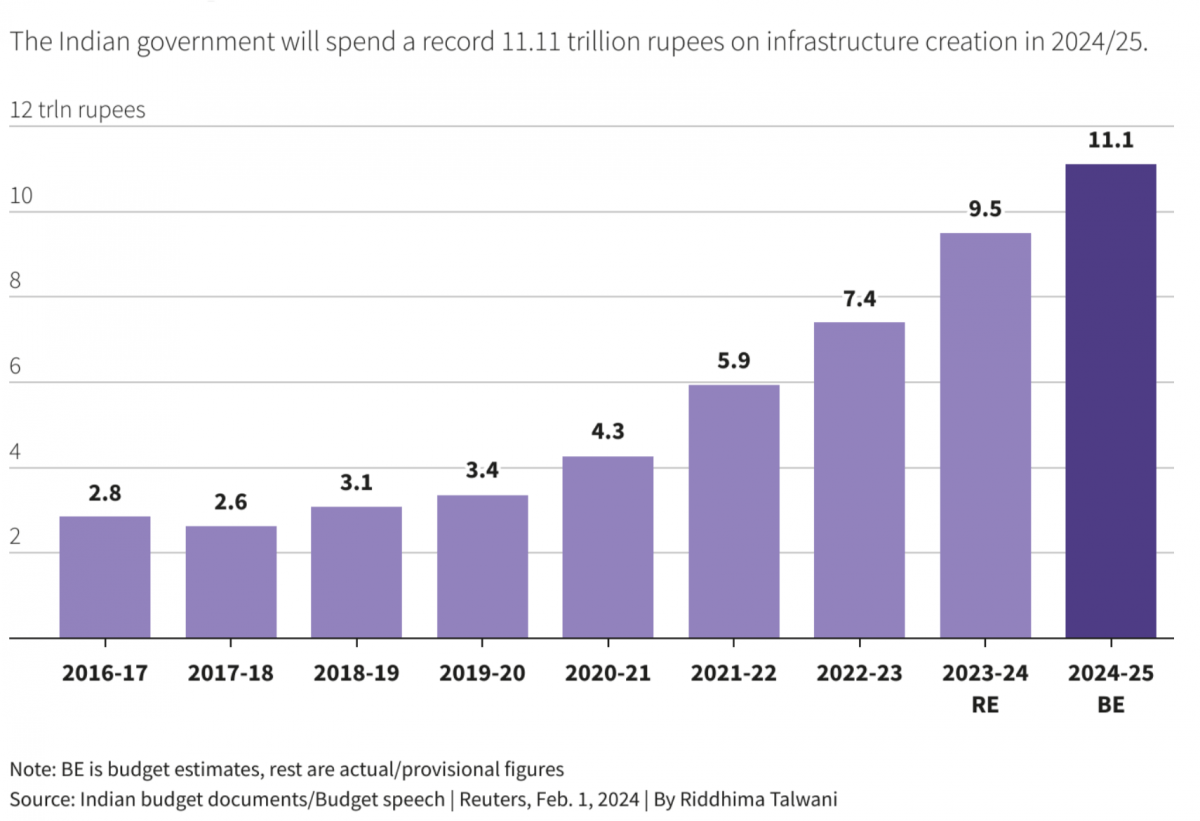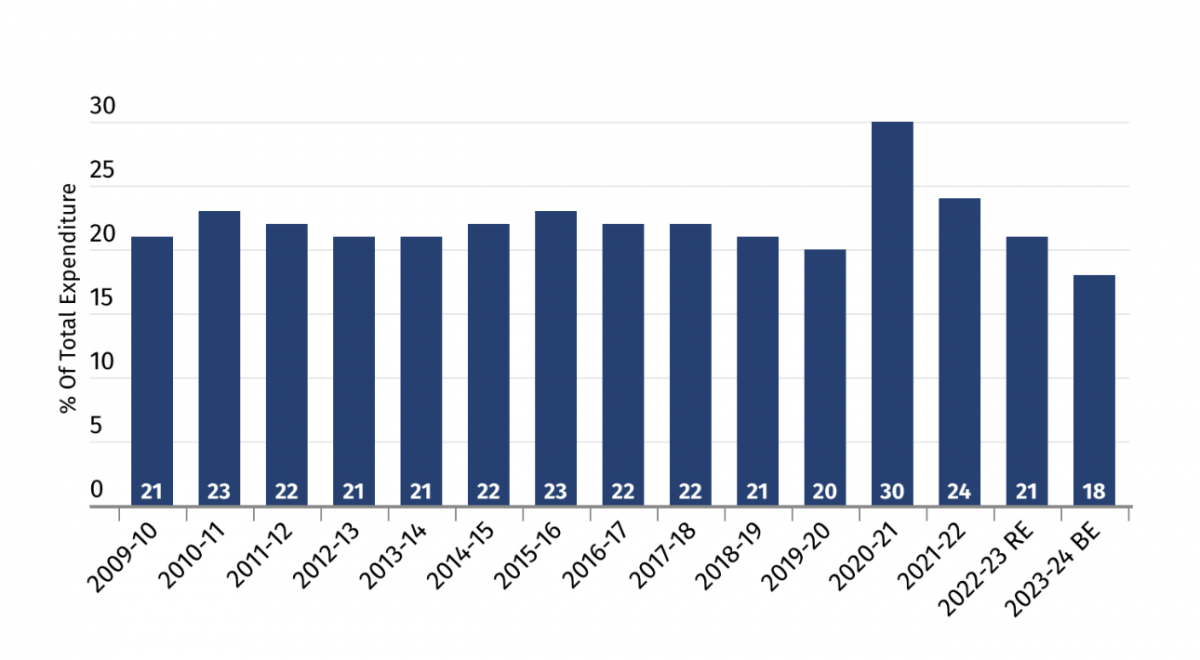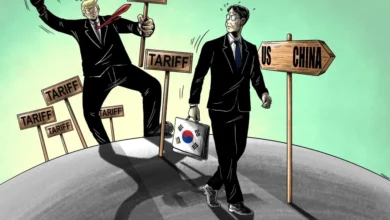Unemployment Crisis Highest In 45-Years: Budget 2024 Does Not Solve For It
A more cohesive approach to functional literacy and competitive skilling is required to genuinely bridge the skill gap and improve employment prospects. This approach should ensure that training programs are aligned with job market needs, that sustainable funding is secured, and that robust mechanisms are integrated to track progress and impact.

In the 2024 Union Budget, the finance minister implicitly acknowledged the unemployment crisis, the nature of structural gaps observed in India’s “jobless growth” trajectory, which has continuously observed a higher output-employment gap and a weakening trend in macro-labor productivity levels, following years of apathetic neglect and macroeconomic policy indifference to critical government voices.
The Narendra Modi government has prioritized the suppression of critical voices and the deployment of Directorate of Enforcement (ED) officials for “fear” and “punishment” over the resolution of the factors that undermined the Bharatiya Janata Party (BJP) during the most recent elections.
The Modi government, in its third elected term, appears to have finally awoken from a deep slumber through specific fiscal interventions that are designed to “nudge the corporate industry” to hire more workers.
These interventions have taken the form of “apprenticeship,” “internship,” and other skilling-centred programs, and they have projected a “deeper awareness” of the structural electoral impact of critical issues such as high youth unemployment, rural distress, and high food inflation in recent (and most likely future) polls.
The economic landscape of India is perpetually challenged by unemployment, which is a critical issue. In a nation with a diverse workforce and one of the world’s most populous, fluctuations in the unemployment rate have significant implications for the country’s progress and development. Therefore, what is the current unemployment rate in India?
Unemployment Crisis
As per the India Employment Report 2024, which was jointly developed by the Institute for Human Development and the International Labour Organization (ILO), India’s working population increased from 61% in 2011 to 64% in 2021.
It is anticipated that this figure will reach 65 percent by 2036. Nevertheless, the percentage of young people who were engaged in economic activities decreased to 37% in 2022. In order to promote sustainable job growth and ensure the nation’s future prosperity, it is imperative to maintain vigilance and implement effective policy measures.
As per the most recent data from the Centre for Monitoring Indian Economy (CMIE), an independent think tank, the unemployment rate in India was 9.2% in June 2024, a significant increase from 7% in May, 2024.
In June 2024, the Consumer Pyramids Household Survey conducted by CMIE revealed that female unemployment surpassed the national average at 18.5%. This represents an increase from the 15.1% recorded during the same period in the previous year. Simultaneously, male unemployment was 7.8%, which was marginally higher than 7.7% in June 2023.
The labor force participation rate (LPR) is the percentage of the working-age population (15 years of age and older) that is either employed or actively seeking employment. The rural unemployment rate increased from 6.3% in May to 9.3% in June 2024, while the Labour Participation Rate (LPR) increased from 40.8% in May to 41.4%. The urban unemployment rate increased from 8.6% to 8.9%.
Here are the national unemployment figures from 2008 to 2024 (June), as recorded by the CMIE:
June 2024: 9.2%
2023: 8.00%
2022: 7.33%
2021: 5.98%
2020: 8.00%
2019: 5.27%
2018: 5.33%
2017: 5.36%
2016: 5.42%
2015: 5.44%
2014: 5.44%
2013: 5.42%
2012: 5.41%
2011: 5.43%
2010: 5.55%
2009: 5.54%
2008: 5.41%
 BJP Government Made Hollow Promises, With No Implementation Pathway of the Policies
BJP Government Made Hollow Promises, With No Implementation Pathway of the Policies
The current economic challenges and the need for sustainable development in rural and urban areas necessitate the implementation of thoughtful policy measures in response to the evolving trends in labor demand and employment rates.
It emphasizes the necessity of diversifying economic activities in order to generate jobs.
In a democratic republic, an electorally sound feedback information system that allows voters to clearly inform the government of their priorities may be well-received and celebrated. However, it is necessary to engage in critical reflection and soul-searching to determine the extent to which the government’s policy-making knowledge system and its “intent” and capability are capable of addressing the issues at hand, as it has promised.
The focus of this discussion is not so much on “intent” as it is on the application of policy and the consequential links that result from it. Specifically, the question is whether these links are consistent (or convergent) with the intended objectives of the policy.
The intellectual bankruptcy that has befallen the government’s core economic policy think tank, which is surrounded by ignorant bhakts rather than serious, intuitive minds, is a reflection of the challenge of determining whether the current government is actually cognizant of the complex issues at hand, such as high youth unemployment, high informality, deep structural underemployment, and a widening rural-urban disparity in employment patterns, which are visible across a disjointed, asymmetric labor market.
The government has made a significant electoral commitment to the generation of high-quality employment. However, a report by the National Sample Survey Office (NSSO) showed a major increase in unemployment, which tripled from 2.1% in 2012 to 6.1% in 2018 and further increased to 7.4% in 2019.
Despite claims of creating over 70 lakh jobs in the financial sector in 2017, the unemployment rate increased significantly.
The employment creation and unemployment action numbers have been distorted by a variety of government-sponsored surveys and “new” studies that are more interested in establishing an alternative narrative (to present a favorable image for the government) than in identifying the real challenges facing the employment landscape.
We should examine the macro-data more attentively.
The rate of overall employment growth, which was initially modest at 1.7% per year between 1993 and 2004, experienced a significant decline after 2004 and became negative after 2011.
The exclusion of “unskilled” and “low-skilled” laborers from the job market was a significant factor in this decline. Between 1993 and 2017, there was a consistent decline in the employment of unskilled laborers, and the growth of low-skilled employment was negative from 2011 to 2017.
Even qualified workers experienced a substantial decline in employment growth following 2011, suggesting that job creation was inadequate for this demographic.

In a complex, profoundly fractured, and heterogeneous labor market scenario such as India, the normative, applied, and policy-based understanding of “skilled,” “semi-skilled,” and “unskilled” jobs remains a debatable issue that warrants a separate discussion. Nevertheless, we concur.
The nature of widespread informality, poor implementation of MWAs (Minimum Wage Acts), and socially identified indignation experienced towards “work” further complicate this conceptual issue and more contested issue of “skilling.” This is in addition to a higher acad-industry gap, which renders those educated too less functional in a competitive job market.
Consequently, any degree of government program-based “skilling” for better employment creation is an impossible task.
When it comes to competitive skilling initiatives, targeted efforts in specific sectors may likely be effective. However, the evidence on this matter must be thoroughly examined before crores of taxpayer funds are invested in a new policy “lobbying group” to capitalize on it.
The soap operas of PLI, Make in India, and Digital India, among others, have failed to generate substantial returns on taxpayer funds, resulting in the exploitation of the impoverished (as a result of the reduction in essential revenue expenditure for centrally funded schemes).
Where “skilling” is effective is in the deliberate training of employees in specific sectors, where they are either already employed or are undergoing training to be recruited after a more structured, robust filtering mechanism.

This has been more successful in smaller, more industrialized nations such as Japan, South Korea, Vietnam, and Taiwan. This is due to the fact that educational training has been integrated into “skill-focused learning,” which has increased the employability of those who have completed the educational assembly line.
In the Indian context, neither the individuals responsible for the design or management of the (higher) education landscape have prioritized the establishment of a more robust connection between academic and industry to promote higher employability and skill-based learning, nor has the industry as a whole made significant investments in this regard (with the exception of those employed in labor-intensive sectors).
Most private sector investors and corporate giants have opted for capital investment that is primarily focused on investible profitability rather than the creation of “labor” value of production within or across the sector. This is also a point that the CEA hopes to emphasize in the most recent Economic Survey. However, this issue has been widely recognized for many years.
The primary inquiry is how the Modi government failed to recognize this while simultaneously taking minimal action to either attract labor-intensive private capital or to encourage “job-creating” sectors through fiscal measures.
Nevertheless, this government has made every effort to disrupt and gradually end the (preexisting) human capital formation system, which was protected by public education, research development-based funding, and limited spending on both human capital needs (education, healthcare) and social security (those in need of employment-based safety nets like the Mahatma Gandhi National Rural Employment Guarantee Act (MGNREGA).
Employability Issue In The Country
A critical 2023 paper by late development economist Ajit Ghose emphasizes a pattern of “exclusive growth” in India’s economy since the early 1990s, primarily benefiting the urban wealthy. Ghose noted that skilled employment continued to expand, albeit insufficiently. At the same time, low-skilled workers were increasingly excluded from the job market.
Deepanshu Mohan for the Wire reports how under the leadership of Prime Minister Modi, the employment rate among semi-skilled workers has plummeted at an alarming rate, particularly in regions that were once hubs of job creation. This rapid decline underscores the urgent need for intervention in India’s employment landscape.
This decline is further exacerbated by a demand-side crisis that has impeded the success of supply-side economic policies, despite the rhetorical initiatives of the ‘Make in India’ campaign and the Production-Linked Incentive (PLI) scheme, as well as profoundly exploitative worker contracts (evident in self-employment and casual work, which are more unorganized and informal).
However, these government-sponsored initiatives have failed to generate the anticipated sectoral growth, as they have failed to generate skilled employment opportunities for individuals seeking employment in manufacturing-related sectors or to generate the anticipated fiscally targeted, subsidized, and direct government intervention.
The Ministry of Skill Development and Entrepreneurship was established in 2014 with the ambitious objective of training 300 million individuals by 2024. Absorbing the National Skill Development Corporation (NSDC) and other programs, this was achieved. Nevertheless, these initiatives have not been as successful as anticipated, even though they have partnered with a variety of organizations and have raised awareness.
The current education system is outdated and not job-oriented to meet the demands of the industry and tech-restructured employment landscape, according to experts and more intuitive macroeconomics (observing sectoral trends and employment-output linkages).
Accordingly, traditional degrees and government-sponsored skilling programs no longer guarantee good, organized employment. This is evident in the fact that only a small percentage of candidates who have been certified by the Pradhan Mantri Kaushal Vikas Yojana (PMKVY) program have been able to secure employment, which underscores the fundamental challenges in the current skilling initiatives.
Here, the Economic Survey 2023-24 emphasizes a critical issue: The majority of India’s population, approximately 65%, is under the age of 35, and a significant number of them lack the necessary skills to thrive in a contemporary economy.

The survey also indicates that only approximately 51.25% of the country’s youth is considered employable, indicating that approximately one in two graduates are not immediately employable upon graduating from college. This issue is further substantiated by the India Skills Report (ISR) 2024, which indicates that only 50.3% of graduates from higher educational institutions are deemed employable.
The NSDC conducted a skill gap study from 2010 to 2014, which predicts that India will require nearly 109.7 million additional skilled workers in a variety of sectors by 2025. The study also underscores the critical issue of the widening skill gap, which is characterized by the fact that the average Indian worker is not as skilled or employable as a foreign worker in the same occupation and employment category because the latter is more competitive.
Social investment for human resources formation has not maintained pace with the substantial increases in capital expenditure, which have increased from Rs 465,277 crore in 2015-16 to Rs 11,11,111 crore in the current Budget.
This disparity emphasizes the difficulties associated with effectively addressing the skill divide. The government has implemented a variety of policies to encourage employers, promote export-based manufacturing, and promote self-employment; however, these initiatives have not yet yielded the anticipated results.
The success of these efforts has been delayed by the discrepancy between low social investment and increasing capital expenditure. Although the 2023-24 Budget saw increased capital investment spending, the social sector received less than 20% of CapEx.

A further decrease to 18% was observed in the 2023-24 Budget. The government’s endeavors to prepare the workforce for contemporary economic demands and bridge the skill gap are rendered insufficient in the absence of corresponding increases in social expenditure to support these initiatives.
Furthermore, investments in employment schemes for the social sector have been significantly diminished and have been redirected toward more recent initiatives. The redirection of funds from older employment programs (such as MGNREGA) has further confounded these efforts to address the unemployment crisis.

The diminishing support for traditional programs, the influx of young people into the workforce, and the increasing unemployment rates emphasize the necessity of a more equitable and productive approach toward tackling India’s employment and skill development challenges.
Internship Scheme Budget 2024: What Is It?
According to Finance Minister Nirmala Sitharaman, the scheme will provide one million young individuals aged between 21 to 24 with internship opportunities at 500 of the country’s most prominent companies. A monthly allowance and a one-time assistance amount will be provided to the trainees under this program.
The scheme provides a monthly allowance of ₹5000 and a one-time assistance of ₹6000 to the youth. Initially, the scheme will operate for two years, followed by a three-year second phase.
The proposal stipulates that the companies will be responsible for the cost of training the youth, and they will contribute 10% of the apprenticeship costs to their corporate social responsibility (CSR) funds. The application will be received through an online portal, the specifics of which have not yet been revealed.

The internship will last a year, and the interns would have to mandatorily join the job market soon after the internship ends. There has been no clarity on how the government would ensure it happens.
A catch is the interns cannot be from the top institutions such as IITs, IIMs, IISERs, CA, etc.
Concerns with the Feasibility of Its Implementation
- Little scope for upskilling: Only covering ₹500/month per intern leaves firms with very little initiative to invest in training properly.
- 4000 interns per year per firm, or 20,000 interns in 5 years, is a huge workforce to handle, even for large organizations with adequate resources.
- A stipend of ₹5000/month, while it seems reasonable, can’t cover living expenses in a metro city, making the move challenging for Tier-2 and 3 cities youth.
- Most top firms already invest heavily in internship programs. Thus, interns hired through the scheme may just be CSR numbers for records without value addition.
- One year’s duration is too long. The average internship duration is 3.66 months. Companies may hesitate to invest in such a large chunk of interns for so long.
Low Stipend
A stipend of ₹5000/month, or ₹225-250/day, lies the in lower bandwidth of India’s minimum wage spectrum (₹178-423/day) and is unaffordable due to rising costs for cities.
Average stipend in 2023: ₹8,000/month. This may have a negative ripple effect as companies may start capping their internship allowance at ₹5,000/month.
The better way to go is to introduce performance-based stipend payout, which rewards high-performers and ensures that low-performers do not get undue benefits.
Revise stipends as per the cost of living in the city where the internship is based out of.
May Remain Just a CSR Activity for the Books
Since the interns are not from top colleges, companies may participate in the program for mere publicity, hiring interns to fulfil their CSR without cost concerns pressure as expenses are primarily borne by the government.
The interns may not get appropriate training and support, defeating the core purpose of the initiative.
An accountability mechanism needs to be implemented to track and hold companies responsible.
4000 interns per firm for a year is too big a number
Span of control will increase, which would deprive interns of individual attention and support.
A more pragmatic approach is to increase the number of companies, bringing down the number of interns per firm.
Conclusion
Consequently, despite the government’s rhetorical positive shift toward skill development, the actual, measurable effectiveness of these new initiatives may remain weak and primarily rely on overcoming ongoing challenges such as high unemployment.
In order to genuinely improve employment prospects and bridge the skill gap, a more cohesive approach to functional literacy and competitive skilling is required. This approach should integrate robust mechanisms for tracking progress and impact, ensure sustainable funding, and align training programs with job market needs.
In order to transform ambitious plans into tangible outcomes and cultivate a workforce that is capable of meeting the demands of a modern economy, it will be essential to address these issues fiscally and through increased private-sector partnerships for job/labor-intensive sectors.




